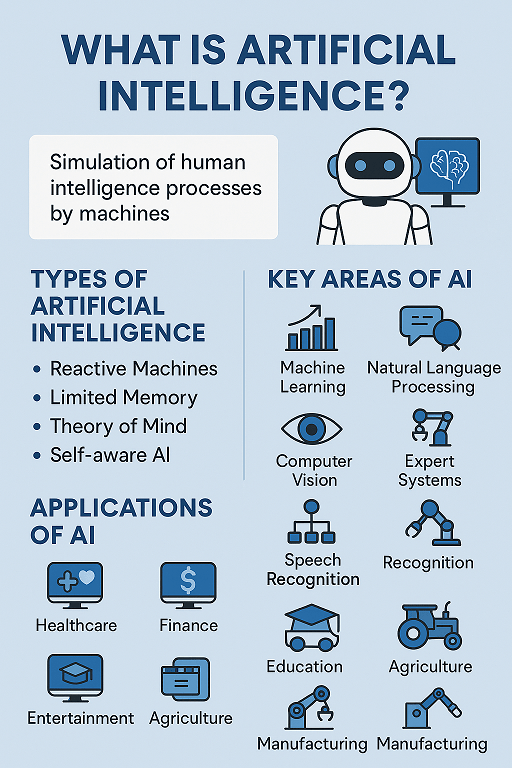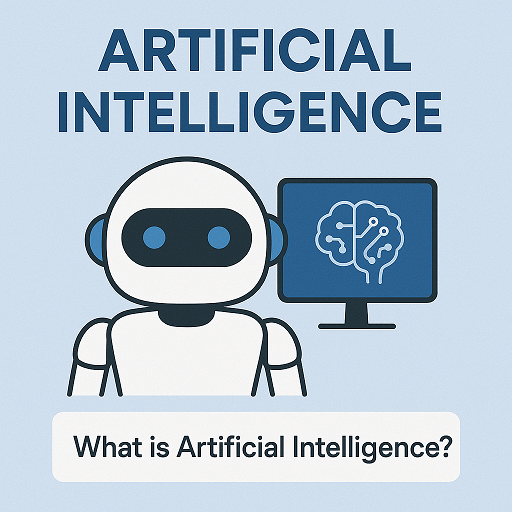What is Artificial Intelligence? A Beginner’s Guide
Artificial Intelligence (AI) is everywhere today, from voice assistants like Siri and Alexa to movie suggestions on Netflix and even self-driving cars. But what exactly is AI? How does it work? And why is it so important?
In this blog, I’ll explain AI in simple terms and walk you through its types, uses, benefits, and future.
What is Artificial Intelligence?
AI means creating computer programs or machines that can think and act like humans. These machines can solve problems, learn from experience, and make decisions, just like we do.
A Little History
- In 1956, the term “Artificial Intelligence” was introduced by John McCarthy.
- Over the years, AI has evolved from playing chess to writing emails, driving cars, and performing a range of other tasks.
Types of AI
We can group AI in two main ways:
A. By Ability
- Narrow AI – Does one task very well. Example: Google Maps or a face recognition app.
- General AI – A future idea. A machine that can do anything a human can.
- Super AI – Smarter than humans. Still only a concept for now.
B. By Function
- Reactive Machines – Can respond to inputs, but don’t learn from past experiences. Example: Chess-playing computer.
- Limited Memory – Learns from past data. Example: Self-driving cars.
- Theory of Mind – Future AI that understands emotions and human thoughts.
- Self-Aware AI – Not yet real. Would be fully conscious like a human.
What Areas Does AI Cover?
Here are some key parts of AI:
- Machine Learning – Learning from data and improving automatically.
- Natural Language Processing (NLP) – Understanding and generating human language.
- Computer Vision – Understanding images and videos.
- Robotics – Building robots that can perform tasks.
- Expert Systems – Making smart decisions like human experts.
- Speech Recognition – Converting speech into text.

Where is AI Used in Real Life?
You might not notice it, but AI is all around you.
By Industry:
- Healthcare – Helps doctors diagnose diseases and suggest treatments.
- Finance – Detects fraud, helps with investments.
- Retail – Suggests products, powers chatbots.
- Transportation – Self-driving cars, traffic predictions.
- Education – Personalized learning apps and auto-grading.
- Entertainment – Recommends music and shows (like on Spotify or Netflix).
- Farming – Monitors crops and predicts harvests.
- Manufacturing – Predicts machine problems, controls quality.
What Are the Benefits of AI?
- Saves Time – Automates boring and repetitive tasks.
- Improves Accuracy – Makes fewer mistakes than humans.
- Works 24/7 – No breaks or sleep needed.
- Personalized Experience – Gives custom suggestions.
- Helps in Big Decisions – Analyzes huge data sets fast.
What Are the Challenges?
While AI is powerful, it also has some downsides:
- Job Loss – Some jobs might be replaced by machines.
- Bias – AI can be unfair if trained on biased data.
- Privacy – Can misuse personal data.
- Fake Content – Deepfakes and AI-generated lies.
- Lack of Clarity – Some AI systems are hard to understand.
- Ethical Issues – Hard to decide what’s right or wrong for AI.
What’s Next for AI?
The future of AI looks exciting and full of potential:
- More Explainable AI – Easier to understand how AI makes decisions.
- Smarter Devices – AI + IoT will bring smart homes and cities.
- Creative AI – AI helping in art, music, writing.
- AI for Good – Solving climate problems, predicting disasters.
- Responsible AI – Making sure AI is fair and safe for everyone.
Final Thoughts
Artificial Intelligence is changing the world. It helps us work faster, solve big problems, and live smarter. But it also brings some risks that we need to handle carefully.
“AI won’t replace you, but a person using AI might.” – Unknown

Post Comment